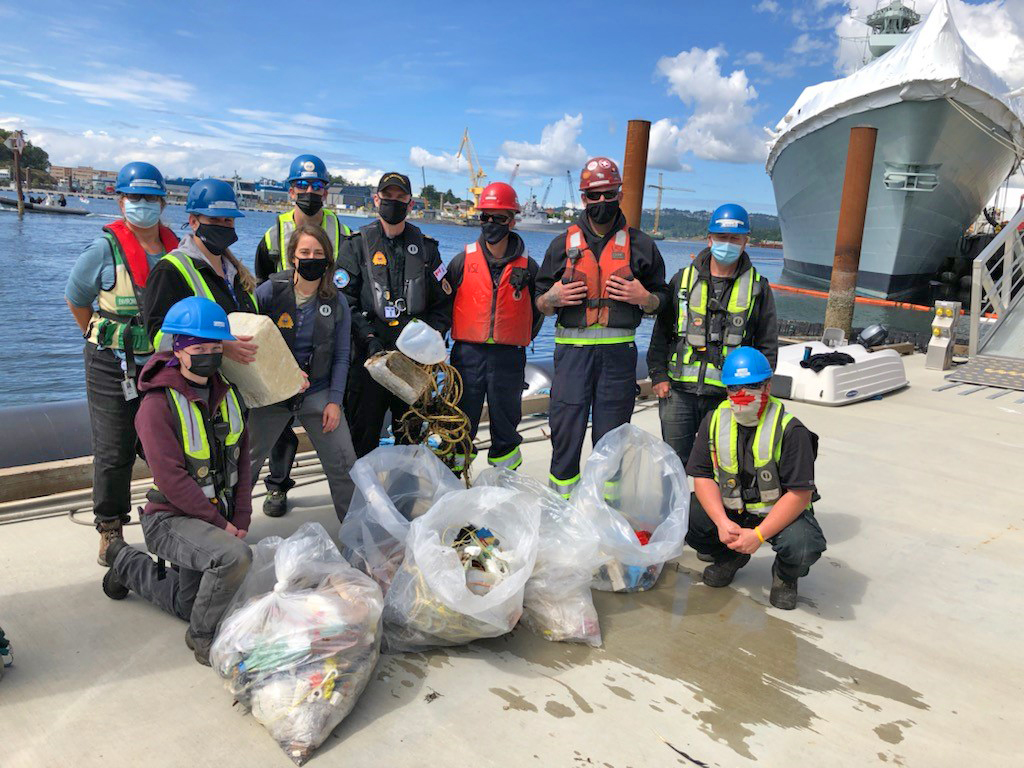Esquimalt Harbour cleanup for World Ocean’s Day
By Lookout on Jun 16, 2021 with Comments 0

Everyone together post cleanup, from left to right: Alanna Morbin, Esquimalt Graving Dock (EGD), Melissa Piasta (EGD), Karlee Munro (in front, EGD), Lorraine Crinkley (front, POESB), Chris Gates (EGD), Chief CPO2 Howie Manderson (POESB), Dylan Goddard, Victoria Shipyards (VSL), Peter Mitchell (VSL), Greg Longbottom (EGD), and Lee Park (EGD).
Lorraine Crinkley
Branch Environment Officer, Port Operations and Emergency Services Branch
––
To celebrate World Ocean’s Day on June 8, CFB Esquimalt’s Port Operations and Emergency Services Branch (POESB) organized a half day ocean and beach clean-up in and around Esquimalt harbour.
POESB was joined by both the Esquimalt Graving Dock and Victoria Shipyards – Seaspan, who also occupy the harbour.
World Ocean’s Day recognizes the impact of human activity on oceans and mobilizes and unites the world’s population to practice sustainable management of these bodies of water.
Debris was collected from the Esquimalt harbour, with a focus on the jetties and compression fenders where waste tends to collect, and from various pocket beaches.
Collectively, POESB, Esquimalt Graving Dock and Victoria Shipyards – Seaspan removed approximately 109 pounds of waste. The predominant types of waste were plastics, Styrofoam, and rope. Other types of waste included cigarette butts, protective ear buds, medical masks, and treated wood.
The most challenging type of waste is by far Styrofoam (expanded polystyrene), most of which has fragmented into small bead-like pieces. Not only do these small pieces collect in hard to reach areas, such as between compression fenders, but they also readily stick to almost anything due to their electrostatic attraction to other objects. The fragmented Styrofoam pieces adhere to infrastructure and biological material making them extremely difficult and tedious to recover. These pieces pose a threat to the environment due to their inability to biodegrade, the petroleum-based composition, and the health impacts to the wildlife that ingest them.
Here are a few things people can do to help reduce the amount of Styrofoam in our environment:
- Educate yourself and others on the impacts of Styrofoam on the environment;
- Use re-usable cups for your daily coffee;
- Use your purchasing power. When grocery shopping or getting take out only purchase products that are packaged in non-polystyrene materials; and
- Help remove Styrofoam from your local beaches and waters through organized clean-ups or on your own.
If you are interested in participating in one of POESB’s ocean or beach clean-ups, or you would like help organizing one within your own unit, reach out to the POESB Environment Officer Lorraine Crinkley at lorraine.crinkley@forces.gc.ca.
––––
Filed Under: Top Stories
About the Author:





